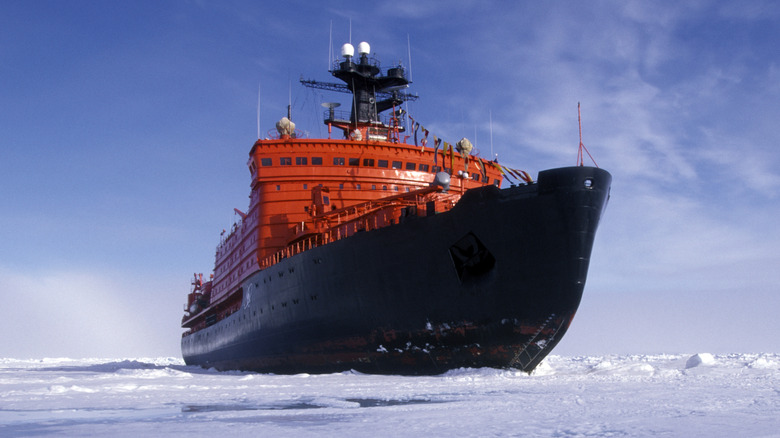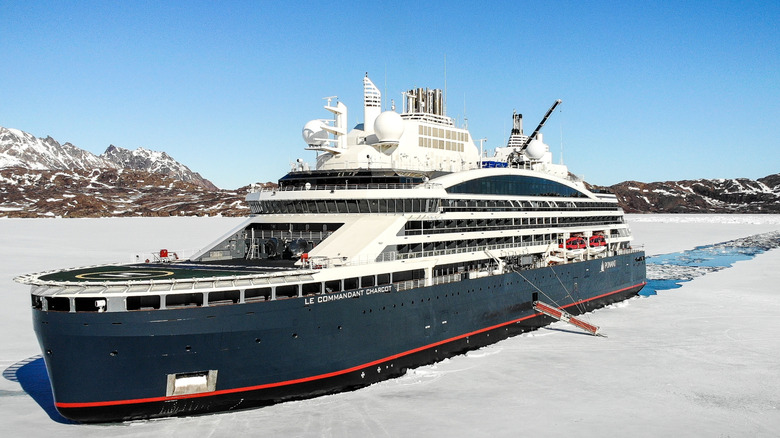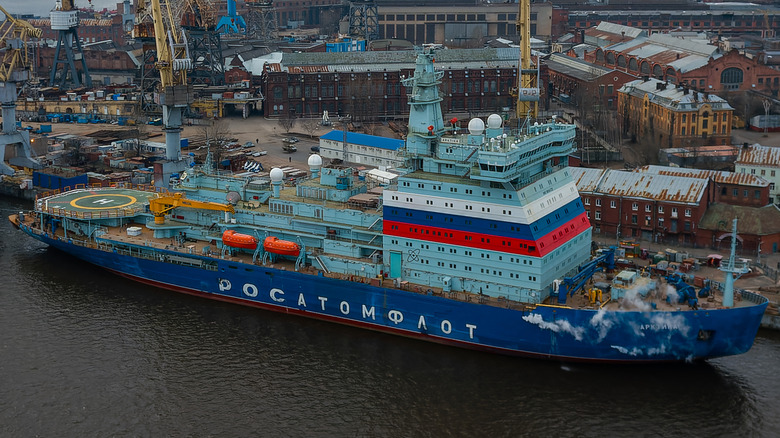What Is An Icebreaker And What Makes It Different From Other Ships?
Icebreakers are highly specialized ships with the ability not just to sail the seven seas, but also to crash through the ice on frozen oceans. Taking to ice-laden water has always been fraught with danger and as sea ice in the Arctic recedes as a result of climate change, more and more ships are taking to northern routes. Among the dangers that ships navigating such waters face are hitting ice, ice buildup, and becoming "beset" in ice. The latter is the most hazardous and often requires an icebreaker's assistance to help them break free. This is one situation where the icebreaker's unique attributes are useful, but it's far from the only one.
Icebreakers are the workhorses of our frozen waters. They can be used as research ships, exploration ships, offshore support vessels, and even tugboats strong enough to tow massive ships. There's even a luxury cruise ship officially classified as an icebreaker. It might not have made our list of the strangest ships in the world, but Le Commandant Charcot has an Ice Class of PC2 (more about the Ice Class system later), which means it can cruise to destinations like Greenland, Svalbard, and the Geographic North Pole.
But what makes an icebreaker an icebreaker? And how do such ships safely navigate waters that can be deadly to normal vessels? Let's break the ice and see what an icebreaker is, and how it differs from other ships.
What is an icebreaker?
Before we look at the technical differences between an icebreaker and other ship types, there are classification systems that define what makes an icebreaker. These include Russian Rules, Polar rules, and Canadian Arctic Shipping Pollution Prevention Regulations rules. However, the International Association of Classification Societies developed a series of unified requirements based on these rule sets to create the Polar Class classification system. Under these regulations, ships are given a PC rating that ranges from PC1 through to PC7. Ships with a PC1 to PC5 rating are considered capable of navigation in Arctic waters year-round, those with PC6 and PC7 ratings only in the summer. Ultimately, this classification defines the difference between icebreakers and other ships.
From an engineering standpoint, various design attributes are considered when classifying icebreakers. The hull is an obvious place to start. Icebreakers' hulls need to be strengthened to withstand ice's impact. Typically, icebreakers feature double hulls with a thickness of about 2 inches at the bow and other ice-breaking areas, and about 1 inch elsewhere.
The shape of the bow is also important. Icebreaker hulls aren't designed to break the ice by cutting through it — they're designed to ride up on the ice and let the ship's weight break it. This requirement means that icebreakers generally offer a rounder, sloped hull shape, while other vessel types have sharper bows that let them cut through water more easily and efficiently.
Examples of notable icebreakers
To help differentiate between icebreakers and other ships, it's useful to look at some specific icebreaking ships and the design features that earned them the classification. First on the list is the Arktika, a nuclear-powered Russian icebreaker. At 569 feet long, it's the world's most powerful icebreaker and can break through ice nearly 10 feet thick. The Arktika is powered by two nuclear reactors that give the ship an impressive 73,756 hp. Its main task is to escort military and commercial ships through Arctic waters.
Next, we need to take a quick trip from Russia to neighboring Finland. The 361-foot Polaris was the first icebreaker to use liquefied natural gas as fuel and can break through ice as thick as 4 feet. The ship, designed to last 50 years, has two Wärtsilä W9L34DF and two Wärtsilä W12V34DF engines that together provide 25,479 hp.
Finally, we can have a look at the U.S. Coast Guard cutter Healy, the most technologically advanced and largest American icebreaker. Designed as a research platform, it has 4,200 feet of lab space that can accommodate up to 50 scientists. The Healy can operate in temperatures as low as minus 50 degrees and continuously cut through ice of up to 4.5 feet at a steady speed of 3 knots (knots are how ships measure speed). In the end, it's this ability to successfully operate in frozen seas that marks icebreakers as different from other ships.


